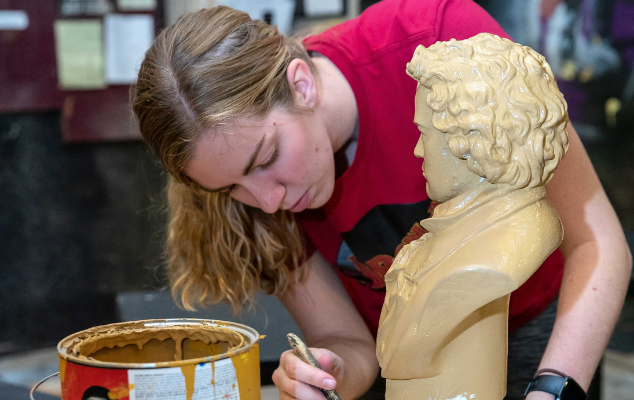Portfolios/Juries
As a professional training program we feel that it is important not just to train our students in their craft but to also prepare them to find work once they have graduated. To this end, all of our emphasis areas have regular opportunities to hone those skills. In design and production, this takes the form of a per semester portfolio review and in performance juries. There is more information about each of these events below. Theatre for youth and communities and communication/theatre/teaching students put together portfolios as a class project toward the end of their coursework.
Each academic year, the faculty provides students with an extended period of time to participate in a “juried” evaluation of their creative/academic progress. The performance faculty use the jury process to obtain benchmarks regarding a student’s degree of growth while in our discipline. The purpose of these juries is not to be punitive, but rather to be formative, providing feedback to students on their progress as performers and to help each student continue to grow.
Because the jury process is integral to the performance curriculum, all performance students are required to participate. Failure to participate in juries shows that your commitment to learning the craft of acting and your trajectory as an artist in the program is questionable. This will lead to a discussion of whether or not you have the professionalism and dedication to continue as a performance emphasis. If you do not jury and do not discuss why you are not jurying with the performance faculty, you will be required to meet with the performance faculty to discuss your goals and commitment to the program.
Parts of the Jury
Jury Presentation
Performance students are to prepare a self-tape with either two contrasting monologue audition pieces OR one monologue and one song with a three-minute time limit (including your slate). You will introduce all pieces at the beginning of the audition and incorporate a slight transition between them. If presenting a song you may sing before or after your monologue.
Additionally, you should submit a headshot and resume.
The performance faculty will complete evaluation forms on each student noting professionalism, preparation, understanding of and suitability of material and more.
Interview
Upon the completion of the student presentation, students will have the opportunity to receive immediate feedback from the faculty and to discuss the presentation. This is an opportunity for faculty to offer immediate feedback regarding the student’s presentation, their choice of material, manner of delivery, etc. Students should consult the jury rubric in this document in their preparation.
Recommendation
After the jury session, the performance faculty will meet to discuss student performance and progress. Students will receive copies of the completed rubrics from each faculty member and a letter with a recommendation regarding their progress in the program. Understand that the feedback and recommendation are provided in order that you may move forward and progress (a sample of the letter is available in the performance student handbook).
Location and Timing
Where
The assessment will take place in the Strayer-Wood Theatre (most often the Bertha-Martin Theatre or the Acting Practice Room ). The specific room will be announced each fall. Students should become well acquainted with the presentation environment.
When
Students graduating in the current academic year (fall or spring) will jury in the fall. This is so performers can prepare material appropriate to the professional auditions in which they will participate as they enter the profession and receive feedback on that material. Sophomores and juniors will jury in the spring. Designated dates for juries will be updated in the handbook every fall semester.
A well prepared portfolio and resumé, and the ability to conduct yourself well in an interview, are crucial to success when searching for a job or a graduate training program.
Every semester, the design and production faculty organize reviews of student portfolios and resumés. These sessions are designed to help students with the guided development of portfolios and resumés.
Portfolio reviews are mandatory for all design and production majors and open to all theatre majors and minors.
New students often feel as if they have no materials worthy of inclusion in a portfolio. This is not the case! Many of the assignments that you will be doing in classes and in production generate work appropriate for a portfolio. What follows are some suggestions for how to develop a portfolio and resumé for the purpose of successfully marketing yourself as a theatre professional.
Portfolio Basics
A portfolio is an organized and creative representation of who you are and what you have accomplished artistically. While the traditional printed portfolio is still an industry standard, creating a digital portfolio to present on a website, laptop or tablet is becoming increasingly important in order to remain competitive in this digital age. When creating your portfolio, keep in mind the following tips.

Show your process.
Document your work as you go through building a project, completing a design or a special class assignment. Demonstrating not just the finished product, but also your process, will show your interviewers how you approach and interpret a creative assignment.

What to include:
Personal artwork that shows your skills, interests and impulses. Work from theatrical productions (ideally, conceptual drawings, process photos and finished production images). Paperwork from the technical side of theatre is also important to incorporate (wardrobe plots, drafting, light plots, samples from a stage management production binder or rehearsal notes).

Make it personal.
Each piece presented should be clearly labeled with the production or class, your role in its creation, your supervisor/mentor/professor (if there was one) and possibly the materials and skills utilized. As your portfolio grows, think about what each piece says about you as an artist and what you can bring to the school or production.
Guidelines for Portfolio Review
Bring sufficient copies of your resumé to every portfolio review, dress appropriately, and follow the presentation instructions specified by the design and production staff. These will be sent out each semester and there will typically be a workshop scheduled to help you prepare and ask any questions you may have.
The format of the presentation varies but you should be prepared to speak about your work and also answer questions.
Portfolio Types for Design and Production Students
Theatre design and production majors are encouraged to maintain two portfolios: a My Work Portfolio and a Professional Design and Production Portfolio.
What is a My Work Portfolio?
A My Work portfolio is a collection of anything and everything you have done that documents your work as a theatre practitioner. It should include everything – class work, all production work, and other work in the form of research, sketches, drawings, renderings, process photos, finished product photos, 3-D objects and models, production paperwork, production photos, programs, posters, etc. This is the master collection from which you will make selections for your Design and Production Portfolio.
What is a Design and Production Portfolio?
A Design and Production Portfolio is a presentation of selected design and production work in a professional portfolio format. This portfolio is one of the most important tools used by theatre practitioners when seeking employment or entry into graduate school.
Tips for developing your portfolio
Portfolio basics

The very best source for how to put your portfolio together is the observation of other student portfolios and the portfolios of theatre professionals. You should take advantage of as many opportunities as possible to see the portfolios of other students and those of working theatre professionals.
Good content is the most important consideration for the development of a strong portfolio. Get into the habit of taking photos of your work, both “in progress photos” and “finished product photos.” If you have materials that have anything to do with a major project, keep it. Save sketches, worksheets, spreadsheets, charts, mock-ups, etc. One thing that is desired by employers and graduate programs is evidence of the process by which designs or building plans are developed and executed.
How to acquire portfolio content
Strayer-Wood Theatre production assignments:
As a student, you may have numerous production assignments that will generate work for your portfolio: foundations running crews, practicum assignments, theatre production assignments, etc.
Class projects:
Class projects are an important source for design and production portfolios. This includes Theatre classes at UNI and any other class that generates work related to Theatre.
Summer theatre work:
Summer theatre work can generate important portfolio materials. Remember to pack a camera!
UNISTA work:
UNISTA productions offer many opportunities for portfolio building.
Strayer-Wood Theatre production photos:
The Theatre Department commissions professional photos of every main stage production. You can access copies of those photos by contacting Katy.McGlaughlin@uni.edu

